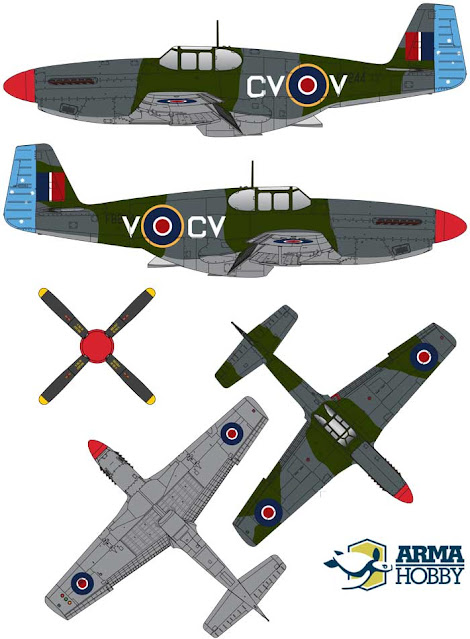Mustang III, FB244/CV-V 3rd Squadron RAAF (Hasegawa 1/72)
Fano - Italy, April 1945
Kit: Hasegawa #AP11 Scale: 1/72
Aftermarket:
- EzLine for the antenna.
- Eduard Photo-etch set #72 110 P-51B/C Detail set for Hasegawa kit.
The kit was originally released in 1992 and have a few issues like:
- The wing is from a D version not a B/C;
- The wheel wells are too shallow; and
- Very minimal interior details.
Originally formed on 1 July 1925, 3 Squadron was one of twelve permanent Royal Australian Air Force Squadrons in existence at the beginning of the Second World War. In the first months of the war the squadron adopted an operational alert status, absorbed new personnel and intensified its training, prior to being identified to accompany the 6th Division of the Second AIF overseas as an attached army co-operation squadron.
Leaving its aircraft behind, 3 Squadron sailed from Sydney on 15 July 1940. Arriving in Egypt on 23 August 1940, the squadron was placed under the command of the Royal Air Force's Middle East Command and organised a three flight army co-operation squadron: two flights were equipped with Gloster Gauntlet and Gladiator fighters and the third with Westland Lysander utility aircraft. It commenced active operations in support of British Commonwealth land operations in the Western Desert on 3 November 1940.
During the next four and a half years, 3 Squadron became one of the most active squadrons in the RAAF, quickly becoming a jack-of-all-trades. In addition to the conventional reconnaissance and ground attack roles of an army co-operation squadron, it defended ground forces and bombers from enemy aircraft, and conducted strikes against enemy shipping. The squadron was involved in the first Allied campaign in Libya between November 1940 and April 1941, and played a critical role in the invasion of Syria in June and July 1941. In September 1941 it returned to the see-sawing war in North Africa, which finally ended with the defeat of the Axis forces in Tunisia in May 1943. Operating from Malta initially, the squadron supported Allied operations in Sicily between July and August 1943. Sicily was a stepping-stone to Italy, which became 3 Squadron's principal area of operations for the rest of the war.
3 Squadron's original aircraft had been replaced by Hawker Hurricanes by January 1941, but for most of the war its principal workhorse was the Curtis P-40, with which it was first equipped in May 1941. Two successive variants of the P-40, known as Tomahawks and Kittyhawks, were employed by the squadron before they were finally replaced by North American P-51 Mustangs in November 1944. In Italy, the squadron adorned its aircraft with a southern cross painted on the rudder, a practice which has been continued by more modern incarnations of 3 Squadron to the current day.
3 Squadron's war was brought to an end by the surrender of German forces in Italy on 2 May 1945. Since November 1940, the squadron had been responsible for shooting down 217 - enemy aircraft, making it the highest scoring British Commonwealth squadron in the Mediterranean theatre of operations. It destroyed another 29 aircraft on the ground in addition to 709 motor vehicles, 28 water vessels of varying sizes, and 12 locomotives. The squadron sailed from Egypt for home on 27 September 1945 and was disbanded at Point Cook in Victoria on 30 July 1946. 3 Squadron was, however, destined to reform in 1948.
Modifications to the kit:
- Cockpit detailed with Eduard P-E.
- The antenna wire was made using EzLine super fine.
- Pilot figure from spare parts box with arm scratch-built to correctly have the controls manned.
- “Turning” propeller scratch-built and painted.
- Decals for this version from the Arma Hobby kit #70038
- Paint scheme:
- Tamiya Acrylic - XF83 Medium Sea Gray 2 (RAF) for underside surfaces.
- Tamiya Acrylic - XF-81Dark Green 2 (RAF) and XF-82 Ocean Gray 2 (RAF) for upper side camouflage.






























